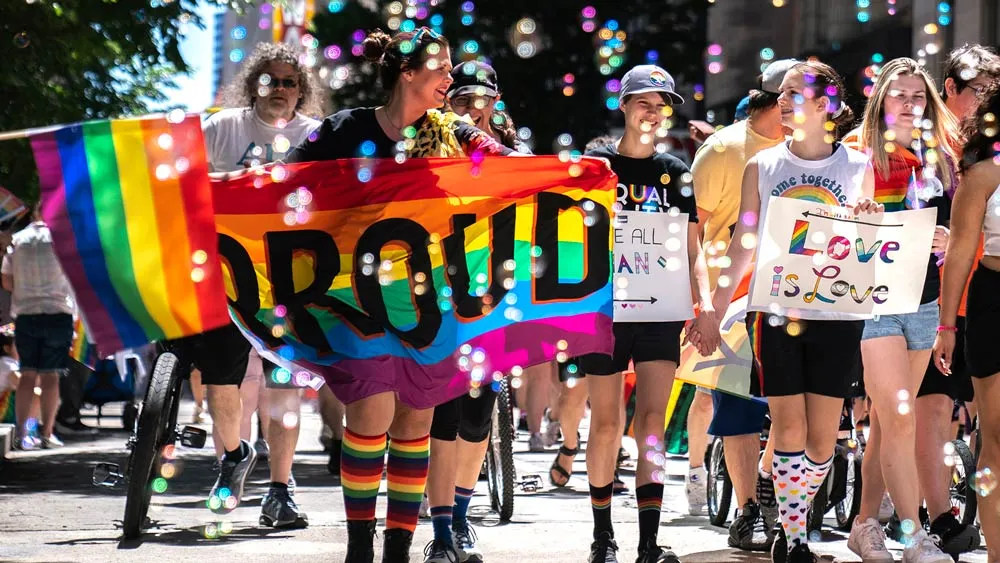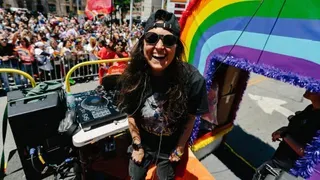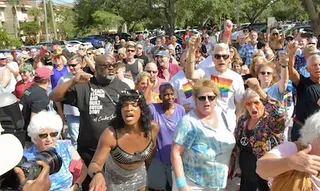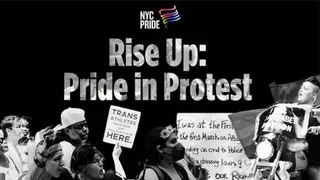July 31, 2012
Pride & Protest Over Uniformed Military Marching in San Diego
Shaun Knittel READ TIME: 7 MIN.
The uniform is the single most recognizable piece of military service. More than a fighter jet, a green bed blanket or a drill sergeant's stream of obscenities, the crisp and clean uniforms proudly worn by members of the U.S. Army, Air Force, Navy, Marine Corps and Coast Guard are symbols of freedom and democracy around the world.
I should know: For nearly a decade, I wore one.
What happened at San Diego Pride and the reaction from gay activists and sympathizers on one side, and anti-gay politicians and bloggers on the other, bears how seriously servicemembers, the Pentagon and the public consider the starched dress uniforms of the various branches of the Armed Forces.
For those of us that served under the reviled and now (mercifully) defunct "Don't Ask, Don't Tell" policy, going to a Pride celebration was not only not a reality, it was considered enough "telling" to get thrown out of the service. Just being at a Pride parade in civilian clothes was considered an act of bravery (or stupidity, depending on how you looked at it).
What A Sight It Was
Before you condemn those who chose to serve and remain closeted, ask yourself: Would losing your career be worth seeing parade contingents and floats packed with half-naked men, drag queens and feather boas? In fact, for many of us the answer was a prideful "Yes!," because no matter the anxiety that accompanied a visit to Gay Pride in a city, we still went.
That makes what happened on July 21 all the more momentous. For the first time, members of the U.S. military marched in the San Diego Pride parade - many of them in uniform.
And what a sight it was! Led by a Marine sergeant wearing her dress blues and bearing the American flag aloft, several hundred members of the military marched through the streets of Hillcrest, the gayborhood for this major Marine port city. An estimated 200,000 people whistled, waved, cheered and applauded as the service members walked the parade route. Some saluted. Others shouted, "Thank you for your service!"
’It Says We Are Equal At Last
According to San Diego Pride officials, participants represented every branch of the military. Although most of the military personnel wore T-shirts designating their branch of service, four dozen active-duty and retired members of the Armed Forces wore their uniforms.
"This is history," Navy Petty Officer Erica Tello, 29, who has deployed as a firefighter aboard the carriers Nimitz and Carl Vinson, told the Los Angeles Times at the event. "Being able to wear our uniforms says that we really are equal, at last."
Gay advocates hailed the announcement, made by a deputy assistant secretary of Defense on July 19, to authorize military personnel to wear their uniforms in the San Diego parade as a clear sign that DADT is gone forever. Because the DoD has clear guidelines prohibiting uniformed service members from making a political statement, the Pentagon told members of the military they could participate in the Pride parade provided they did nothing to bring "discredit" to the service.
There are no reports of an incident involving a uniformed service member at the Pride parade on Saturday.
"It’s Okay..."
Many of those marching have deployed to combat zones or told reporters they have partners who are deployed to Afghanistan or on ships. In fact, the flag bearer, Marine Sgt. Bris Holland, 30, has done two tours in Iraq.
Stewart Bornhoft, 65, retired from the U.S. Army at the rank of Colonel. Bornhoft, a West Point graduate, former Army Ranger and Vietnam veteran, marched with the contingent in uniform. He said the chance to wear the uniform in a gay pride parade "is what we've been working for. It says, 'It's OK to be gay.'"
The event also drew groups of service members assigned to the same unit, or ship. Six sailors from the guided-missile destroyer William P. Lawrence marched in uniform.
To GOP, No Uniforms No Advocacy Events, No Exceptions
"We all took an oath to support and defend the Constitution," said Petty Officer Virginia Hansen, 27, whose job involves guiding weapon systems. "Being able to wear our uniforms shows that it's not just straight people who serve their country, it's all of us."
The historic event also saw service members from different parts of the country participate, like Marine Sgt. James Dunn, 24, a reservist who did two tours in Iraq. Dunn traveled to San Diego from his home in Montana to be in the parade with his partner, a civilian.
"Finally we can stand up and be counted," Dunn said.
Not everyone celebrated the decision to allow service members to march in a Pride parade, however. Several Congressional Republicans challenged U.S. Secretary of Defense Leon Panetta on Tuesday to explain why the Defense Department allowed active-duty troops to wear their uniforms while marching.
In a letter to Panetta, Sen. Jim Inhofe (R-OK) said department rules bar service members from participating in political activities while in uniform. He pressed Panetta on why a waiver was granted; who requested it; and why this particular event in this city was considered over others.
Inhofe, who serves on the Armed Services Committee, maintains that administrative action has been taken against service members who have violated the rule in other, similar, instances.
"If the Navy can punish a chaplain for participating in a pro-life event or a Marine participating in a political rally, it stands to reason that the Defense Department should maintain the same standard and preclude service members in uniform from marching in a gay pride parade," Inhofe wrote.
In a statement accompanying the letter, Inhofe said he was concerned that the Obama administration "continues to force its liberal social agenda on the military by promoting the homosexual agenda, mandating the use of high-cost green energy initiatives, pursuing abortion rights and suppressing the free exercise of religious liberties."
Proven Successful, Out-Gay Military Still Hated by GOP
According to the Pentagon, they had already explained the exception. The department said it made the exception because organizers had encouraged military personnel to march in their uniform and the event was getting national attention.
The waiver only applied to this year's parade in San Diego.
Even after the Obama Administration ended DADT last year with the backing of Congress, several Republican congressmen have been critical of the change in policy and have pushed legislation to limit it. That they're doing this despite any evidence that both the rank-and-file and the higher-up brass not only haven't seen the problems in morale, recruitment or harassment.
In direct contrast to GOP politicians, high-ranking military officials have said the repeal has not had a negative impact on the moral and welfare of troops or military readiness. More than that, they see out-serving personnel as an all-around plus -- as it has been in the Armed Forces of nearly every other Western democracy.
Pentagon officials all the way down to newly enlisted service members have expressed enthusiasm for the Defense Department's decision about San Diego Pride. "I got an email from my admiral last night supporting my decision to wear my uniform," Navy Senior Chief Dwayne Beebe, 38, a culinary specialist who has done multiple deployments, told the Los Angeles Times. "That's a major change."
Shaun Knittel is an openly gay journalist and public affairs specialist living in Seattle. His work as a photographer, columnist, and reporter has appeared in newspapers and magazines throughout the Pacific Northwest. In addition to writing for EDGE, Knittel is the current Associate Editor for Seattle Gay News.





